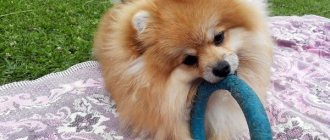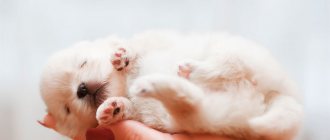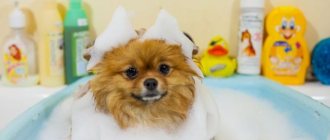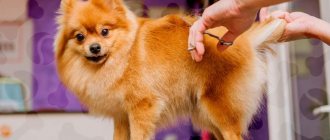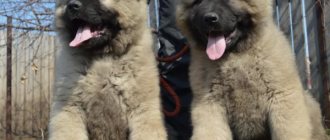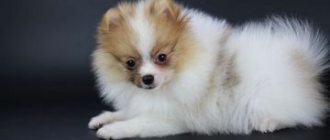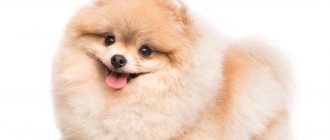Changing a dog's coat is an inevitable natural process. Every owner of a four-legged friend needs to be prepared for this. Long-haired dog breeds, which include the Pomeranian, are especially susceptible to heavy hair loss during the period of coat renewal. Spitz shedding has its own characteristics and comes in several types, which the furry owner should know about. Your pet's fur coat requires careful care during coat changes.
Up to 4 weeks
Pomeranian Spitz cubs are small at birth. They weigh from 55 to 125 g. The baby looks defenseless and vulnerable, he is blind and deaf.
A newborn Pomeranian puppy has a disproportionate ratio of body parts:
- the head is large and compressed;
- elongated body with a voluminous tummy;
- limbs are short.
The body is covered with weak fluff through which the skin is visible. The color of the skin indicates the future color of the animal: light fur grows on pink skin, and dark fur grows on dark skin. Blueness is a sign of possible health problems.
After 10-15 days, the Spitz begins to see clearly, and on the 17th day the ear canals open. By the 3rd week, the cubs begin to empty their bowels on their own, without maternal stimulation. By the end of 1 month, they fully stand on their paws and actively move (video from elyano4ka).
Varieties of shedding
Pomeranians' coat renewal occurs continuously throughout their life. This process is especially noticeable during the period of age-related coat change in puppies, in spring and autumn in adults, during estrus and after childbirth in females.
Depending on the reason that caused the abundant renewal of the coat, the following types of shedding in Spitz are distinguished:
- children's; junior; seasonal; hormonal.
Puppy
Up to 3-4 months of age, a Spitz puppy's fur coat has an irresistible appearance. Babies look like little fluffy bear cubs. Subsequently, the baby fluff begins to gradually be replaced by the main guard hair and undercoat. At this age, Pomeranians may also change coat color.
A shedding Spitz puppy has received the nickname "Pimple" among breeders. The pimpling stage lasts for puppies for up to a year.
The first shedding of a Spitz begins at the age of 4 months. In some representatives of the breed, the process occurs less noticeably. Other Spitz dogs experience excessive hair loss during this period. The pet is partially going bald, which causes unreasonable concern among uninformed owners.
You can tell that your pet is starting to shed based on several signs. At the initial stage, thinning of the fluff is observed on the muzzle. Then the process moves to the dog’s body, paws. Lastly, shedding affects the panties on the hind legs and the collar on the Pomeranian’s neck.
During the first stage of shedding, the puppy sheds almost all of the guard hair and most of the undercoat. At about 20 weeks, the pet's color becomes uneven and paler.
By 7 months, the fur coat gradually “gains” thickness. At this stage, the coat takes on a more saturated color.
Experienced owners claim that if a Pomeranian sheds actively and heavily, then it will subsequently have an irresistible fur coat.
Junior
By 9-10 months, the Spitz begins to grow overgrown, its coat becomes thicker. However, every year the puppies begin the next stage of coat renewal - junior molting.
Active loss of undercoat and main coat occurs. The process lasts on average up to 2 months. At this stage, the puppy's shedding ends, and the Pomeranian gradually begins to acquire an attractive appearance.
What vaccinations does a puppy need?
While breastfeeding babies, passive immunity protects them from infections. With the transition to self-feeding, its effect weakens, so vaccination begins at 8 weeks.
Veterinarians offer a schedule of basic vaccinations, which includes the administration of complex drugs against major infections (hepatitis, leptospirosis, enteritis, distemper, parainfluenza). Combined vaccination of Pomeranian Spitz is carried out at the age of:
- 8-9 weeks;
- 6 months;
- 1 year.
At 12 weeks, in addition to the comprehensive vaccine, the puppy is given an anti-rabies drug.
Would you like to get yourself a Pomeranian?
Shedding process in a Pomeranian puppy
In all adult Pomeranians, the shedding process is less noticeable and occurs twice a year.
At the age of 2 to 3 months, Spitz puppies have an irresistible appearance, reminiscent of small bears, but during the molting period they look very unpresentable. Spitzes first shed the axial hair (this is a long pile that gives the orange a voluminous appearance). The undercoat changes more slowly and imperceptibly, since it is very thick. In some representatives of this breed, during the molting period, a sharp loss of both the axial hair and undercoat occurs; the Spitz resembles in its appearance a hairless Chihuahua. Many Spitz owners are frightened by this, thinking that their pet is sick and begin to panic. But don’t be upset if your pet is unattractive, during the molting period you can trim the puppy, and the fur will grow back at about the age of 8 months (for all Pomeranians this is individual, maybe earlier, maybe later) the Pomeranian’s coat will be bright, thick, shimmering and please your eyes. The sudden shedding of fur by Spitz puppies can be directly related to an unbalanced diet; the baby needs to include proteins, carbohydrates and vitamins in equal amounts in his diet. On the website of the nursery vipyork.com.ua you have the opportunity to buy a Pomeranian Spitz puppy of the bear type, now, during the period of his molting, you will not be surprised by his external changes, but with understanding expect a set of adult hair.
The first puppy shedding of a Pomeranian Spitz (photo and video):
The first shedding of a Pomeranian Spitz puppy begins with the loss of baby hair on its face. In parallel with this process, baldness of the paws occurs, and then the entire body. The growth of adult hair is a slow process, since the Pomeranian grows it gradually. The photo on the left shows the beginning of molting in an orange. Shed parts of the body immediately begin to be overgrown with adult hair. Adult Spitz dogs do not shed as much, especially males; after giving birth, the bitch can completely shed her gorgeous fur (all the center hair, not the undercoat), but within a few months it grows back. While feeding her babies, the bitch loses a significant amount of microelements, vitamins and minerals with milk, and with this her luxurious coat. To preserve your pet’s coat as much as possible, feed your orange with plenty of nutritious, wholesome, and most importantly balanced food. A full set of adult hair occurs in Pomeranians within three years, i.e. Every year the fur coat becomes thicker and more luxurious. During the period of molting of adult individuals, the hair must be carefully combed, in the direction from the tail to the head, because during this period the hair does not fall out of the dog, but gets tangled in the undercoat. During this period, the Pomeranian Spitz needs to be bathed once every 2-3 months, the less often the better, and walked in less dusty places.
Photo gallery
Shedding or pathology?
Spitz shedding is not always caused by natural physiological processes. Disturbances in the hormonal system often cause thinning of a pet's coat.
Baldness can be caused by a deficiency or excess of a certain hormone. Thus, active production of cortisol leads to intense hair loss. The pathological process is also caused by a lack of thyroid hormones.
The age of 10-12 months is considered critical for oranges. During this period, the Spitz puppy may develop alopecia, which is confused with junior shedding. The pathology is characterized by the appearance of bald areas on the body and limbs of the animal. Pathological hair loss is also observed in animals aged 2 to 5 years.
Adult Spitz dogs do not shed as actively as children and juniors. If your Spitz suddenly begins to shed its coat in winter, it should be taken to the veterinarian. Perhaps the animal is beginning to develop alopecia, or has become infected with a parasitic disease. Thinning hair in dogs is characteristic of cheyletiellosis and trichotectosis. The pet not only sheds profusely with these diseases, but also itches a lot.
Another reason why a Spitz sheds is a lack of vitamins in the body caused by the dog’s improper diet.
Stages of development of a Pomeranian puppy by month
If the owner knows what monthly stages of development the puppy goes through, he can understand the reasons for his behavior. The dog owner must be prepared for changes in appearance and understand how to behave as the dog grows. The monthly development of the Pomeranian Spitz can be divided into several phases:
- Newborn – from birth to two weeks.
- Transitional – from the third to the fourth week (hears, sees, orients in space).
- The imprinting phase is from the fourth to the sixth week (they play, remember, explore the world around them).
- Socialization – from the eighth to the twelfth week (formation of relationships with the owner and relatives).
- Determination of a social role - from the thirteenth to the sixteenth week (struggle for leadership, understanding of one’s purpose).
- The phase of determining the hierarchical order is from the fifth to the sixth month (the dog asserts itself).
- Puberty - from 7 months of age to one year.
After the onset of puberty, the puppy grows and develops until one and a half to two years.
Little newborn Spitz
Newborn babies are deaf and blind, weigh from 70 to 140 g, their body size is about five centimeters. They have the sense of touch and taste, and can crawl and squeak. In the first two weeks after birth, they are completely dependent on their mother, but they are already beginning to communicate with humans and fellow animals. In an effort to survive, they fight for a place near their mother, pushing away the weaker ones.
The need for vitamin therapy
During the period when the dog begins to actively shed hair, vitamin therapy may be required. This is especially true for oranges that are fed a natural diet. At this time, the animal especially needs supplements that contain vitamins A, B, C, E, zinc, manganese and sulfur.
Vitamins that are suitable for Pomeranians include VitsCan, Vitakraft VITA-BON Small Dog and Virbac Megaderm. When determining the dosage, be sure to take into account the age and weight of the dog. Food additives stimulate the growth of new hair and make the guard hair shiny and silky.
Proper care of your Spitz during periods of active coat renewal will help avoid problems with your pet’s coat. Unreasonable shedding is a serious reason to contact a veterinarian.
Coat care during the renewal period
During the shedding period, Pomeranians need special coat care. Proper combing will shorten the period of active shedding of guard hairs and undercoat.
It is necessary to comb your pet during coat renewal at least once every 2 days. The procedure takes on average 15 minutes. The dog must be thoroughly combed. This will prevent the appearance of tangles.
The dog is combed with a special comb. After the bulk of the dead hairs and undercoat have been removed, you can use a slicker brush. Some dog owners prefer to use a furminator, which makes the procedure much easier, making it faster.
Deviations in puppy development
It is important to remember that each dog has its own individual characteristics. There is no need to panic if your pet is growing faster or slower than generally accepted standards.
- First of all, the size of a dog is determined by genetics. If the animal's body weight is more or less than generally accepted, it is worth paying attention to its pedigree - most likely, you will find that one of the ancestors had the same characteristics as your puppy.
- The puppy's diet will also affect the growth and development. On natural food, a dog gains weight by 5–6 months, but on dry food, Spitz grow more slowly.
- Don't forget about vitamins - this is an important factor affecting the growth and development of a dog.
- Active walks contribute to the formation of a muscle corset. A puppy who runs a lot will become more athletic and grow taller.
POMERANIAN SPITCH PYRZIK - BEFORE AND AFTER PHOTOS, Spitz at 4 months.
It often happens when a new owner confiscates a cute shaggy little ball from the breeder, and a couple of months later calls in fear shouting: “What did you sell me! We didn’t agree like that!” In general, it is possible to understand the feelings of a freshly-baked owner of an orange. The sight of a little dog is quite a difficult test for the psyche of a new person... especially considering that a tidy sum was paid for the dog.
Chihuahua's false puppiness
What is or who is a pimple? Pyrzik is a puppy in molting condition. At the age of approximately 4 to 6 months, a Pomeranian puppy sheds its puppy coat... This is a natural process that should not be frightened. You just have to get over it.
One day I called the new owners of my 5-month-old puppy to find out how they were doing, and to cheer them up with something like: “Don’t worry, the scarier the little one is. the more beautiful it will be when it grows up...” They were soooo offended by me... They answered me: “Our puppy is not scary at all, he is the MOST beautiful!” Cocker Spaniel English Irkutsk Club And I understood one thing: when you love a dog sincerely and truly, then no shedding will prevent you from loving it less. Low bow to such Owners.
Cost of English Bull Terrier
Since not all owners are in a hurry to show their puppies in an indecent manner, I will post photos of only my personal dogs on this page. Here are my pies - funny and amusing:
American Akita in St. Petersburg
Peugeot boxer minibus heater
Pictures with Spitz dogs
Yorkshire Terrier in Yekaterinburg inexpensively
Did you like our site? Join or subscribe (you will receive notifications about new topics by email) to our channel in MirTesen!

